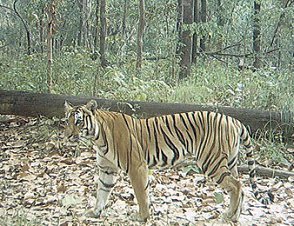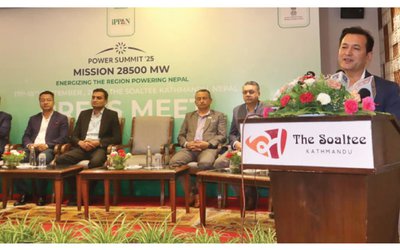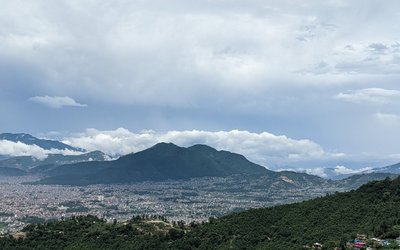
Community based conservation in Nepal is well accepted approach for protection, preservation and conservation of flora and fauna. Especially, community forestry and nature conservation are popular model throughout the world. A number of legal and institutional arrangements were made by blending indigenous knowledge and sponsored technology. Despite of Nepal's small land area and fragile landscape, it is rich in biodiversity and highly popular in ecotourism.It contains 118 types of ecosystems, 35 types of forests and 75 kinds of vegetation. Of the total area, 44.74 percent lands are covered by forests and shrubs and 23.39 percent is under protected areas. In addition, community based forestry cover 42 per cent of national forests. Greening hills or managing Nepal's landscapes are a result of its very good foundation.
We are moving from Millennium development goals to Sustainable development goals era. The ultimate goal of politics is to conserve nature or protect flora and fauna and their habitat. It is well known that nature conservation is basis for sustainable development. In the journey, many people have been devoting their life for conservation. National Parks and Wildlife Conservation Act, 1973, National Forest Plan, 1976, National Conservation Strategy, 1988, Integrated Conservation and Development Program, Master Plan for the Forestry Sector, 1988, Forest Act 1993 and regulation 1995, Revised Forest Policy 2000, National Biodiversity Strategy and Action Plan, 2002, Terai Arc Landscape document, 2004 are major policy documents in the field of conservation.
A number of campaigners had dedication to bring the working environment in the nature conservation. Unfortunately, Nepal lost visionary politician and veteran conservationist including Dr. Harka Bahadur Gurung–a Nepalese geographer, anthropologist, author, artist and a member and Vice Chairman of National Planning Commission (1968-1975), known for his conservation work- on 23 September in Shree Airlines helicopter crash at Ghunsa, Taplejung. A team of 24 people was led by Former Minister for Forests and Soil Conservation moved to Taplejung from Kathmandu on 22 September 2006 and handed over the Kanchanjung Conservation Area to local community after successfully completed the five year KCA project. The community conservation model become a lesson how local communities are real owners to preserve, protect and save our planet from denudation.
23rd September, 2006 become a dark and saddest day and very unrepairable loss in Nepal's conservation history. The human loss incurred by the country as a result of helicopter crash was immense and insurmountable. The conservation and development sectors cannot produce such a dynamic, devoted and dedicated team, nor will Nepal ever have such conservationists to save the denuding Himalayas as had mentioned by many people regarding the event. In 2009, the government declared 7th Asoj to memory of our conservation heroes as National Conservation Day and initiated
A number of strategy and action plans are being produced in recent years to guide all stakeholders in the field of conservation and development right from Churia,Terai and sacred Himalaya landscape, climate change, gender equality and social inclusion, environmental management, sustainable development goals to biodiversity conservation. Some conservation issues are raised by various institutions which need to be resolved jointly by government, non-governmental and community based organizations and private sectors. It is urged that rights of beneficiaries or local communities and Indigenous peoples to access and benefit sharing on natural resources should be ensuredby the government so that the green can be made more greenery and move to green economy. Local government should work closely with inclusive functional community based forestry users, watershed conservation committee and conservation groups for making proper land-use plan throughintegrated watershed and climate adaptation plan to mitigate the ever increasing disaster events. Provincial government should conduct reorientation and joint field observation program on new ideas, social and technical matters as soon as possible. It couldcreate working environment by developing common understanding among diverse and key stakeholders. Proper, disaggregated and reformative reporting system must be established by the government and key stakeholders must support to reporting their activities on the subject matters.
We know that following paths of our heroes is painful. The alternative of conservation is better conservation. Time has come to focus our efforts on holistic and integrated conservation and development. Politics for nature and conservation to uplift people's livelihoods is welcomed from every corners but not for the benefitof party cadre. The government must mobilize the resources for infrastructure develop within a limit of land use plan and land capability. Maintaining good communication and better coordination among stakeholders and development partners are must. We must remember our conservation heroes and follow their path who always follow conservation politics rather than party politics. We must recognize our conservation heroes or predecessors efforts and dedication for forest and nature conservation and encourage the successors' which only can make the conservation journey sustainable.
Paudyal is an environmental forestry expert and can be reached by email : bijayarajpaudyal711@gmail.com

Bijaya Raj Paudyal
Paudyal is General Secretary of Sinamangal Urban Service Society, Kathmandu Municipal-32
- Gene Conservation For Sustainable Future
- May 31, 2021
- Can Nepalese Foresters Revive Their Lost Agenda?
- Apr 12, 2021
- Fire The Uncontrolled Forest Fire
- Mar 29, 2021
- Nepal's Agenda : Simsar Conservation
- Jan 26, 2021
- Community Forestry Journey In Nepal
- Jun 07, 2020












